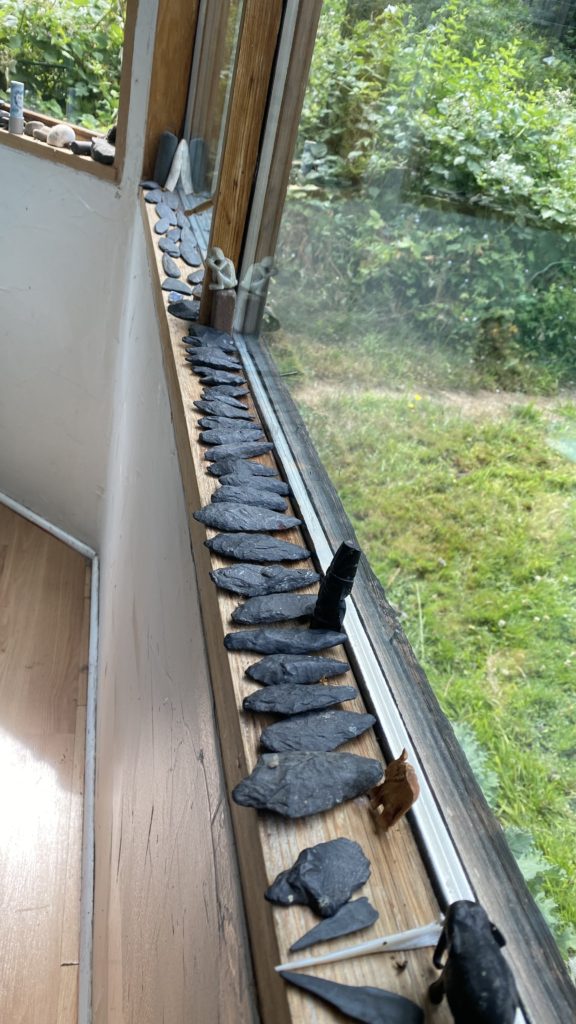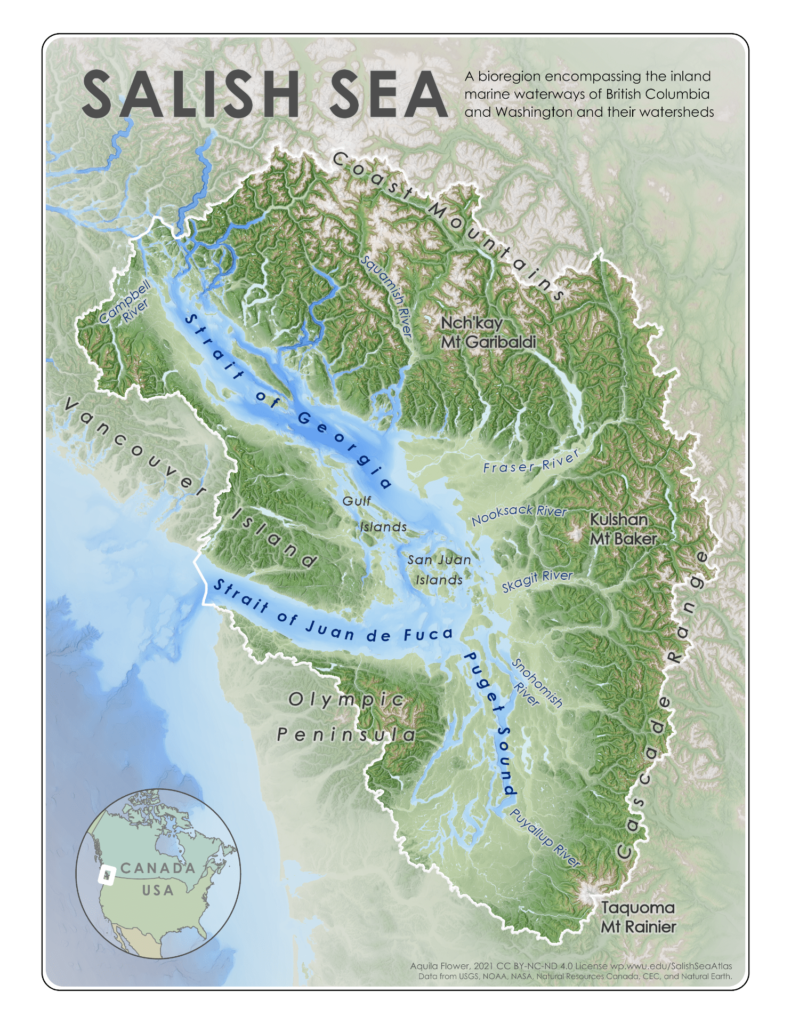I have been stuck for the past several weeks, unable to write my blog – I am getting this in just under the wire before the end of the month. I had planned, after writing about the history of Japanese Canadians and the charcoal kilns (and after that great clickbait title), to write next about our more distant forbears on these islands, the indigenous people who were here well before the white population arrived. Steve, my neighbor, had me over to see his incredible collection of artifacts (see just some of them on his window sill in photo below), collected from the shore and beaches here over the years. He also lent me a couple books on stone tools so I could learn more.

This piqued my interest in the history that resulted in all these amazing artifacts. Who were the people who left them behind? What was their life like?

However, despite some effort, I have struggled to educate myself. I started by going to the Galiano Library and asking if there was a book on the history of native people in the Southern Gulf Islands. The answer was “no.” I then asked if there was something more general about the Coast Salish people in British Columbia and the answer was “no.” Feeling bewildered, I soldiered on asking if they had a children’s book as my abject ignorance would be improved even with some elementary information. But, no. The nice woman suggested I try the bookstore so I got back on my bike and continued on to the mini-town center.
Before I continue my saga, I’d like to mention that in July of 2010, a large area of coastal waters off the south coast of British Columbia were officially named the Salish Sea by both First Nations and government leaders at a ceremony in Victoria. During the ceremony, it was noted that the name pays homage to First Nations history and reflects a growing understanding of native culture. The Lieutenant Governor, who was of aboriginal descent, noted that “Coast Salish peoples have traversed these waters for thousands of years, and this name pays homage to our collective history.”

The new name didn’t replace any of the existing official names for Puget Sound, the Juan de Fuca Strait or the Strait of Georgia near Vancouver but is used to indicate the entire area. It does seem to have caught on and shows up on maps and is used by locals. Just before this naming, in December of 2009, B.C.’s Queen Charlotte Islands were officially renamed Haida Gwaii as part of a historic reconciliation agreement between the province and the Haida Nation. John and I visited Haida Gwaii last summer and saw many of the old first nation communities that are no longer populated but whose remnants of homes and totems serve as a reminder of the flourishing indigenous nations that once populated those islands.
These naming and re-naming efforts are all part of what in Canada is called “Reconciliation.” I don’t know enough about what else it entails to say more.
Ok, back to my self-education efforts. At the bookstore, I was told that they had “just” set up a section on Indigenous topics and to also look in the section on British Columbia. However, the nice fellow in the bookstore when told what I was looking for, said that he thought it did not exist. He admitted this seemed like a hole in the literature. There are books on indigenous groups in other parts of the country and there are books on the work of specific indigenous artists but an overview of the history of the coastal people did not seem to be available. I’d been told about the book The Terror of the Coast: Land Alienation and Colonial War on Vancouver Island and the Gulf Islands, 1849-1863, but this wasn’t really what I wanted either since it wasn’t the colonial genocide I was after so much as a description of the communities that were here before they were destroyed.
My next effort was to contact an archaeology professor at Washington State University who is known to be the expert on the Southern Gulf Islands. We’d spoken to him when we learned that our property is in a designated archaeological zone in order to figure out what that would mean to us (don’t ask!). Unfortunately, he did not respond to my email asking if he had any suggestions about a book I might read. Online research has turned up a variety of books on native legends and stories, art, biographies of specific native people, essay collections, but still nothing I’d call a general history of native people on the coast of BC.
Last week on our way through Vancouver, John suggested we go to the store at the Museum of Archaeology (MOA) at University of British Columbia, a gorgeous museum that we’ve visited several times, to see if they’d have a book for me. A quick google search informed us that the museum is closed for an earthquake retrofit of the great hall, which was not too surprising given that last time we were there, they had buckets set up to catch the leaks coming from the ceiling. So much for that good idea of John’s.
So, finally, I have given up on any quick or easy learning about the indigenous history of these islands. at least for now. One person I met at cocktails last week told me that I could learn a lot by talking to some of the local people, a very few of whom have some indigenous heritage, because they know the history and would have stories for me. While I am eager to do that, it will take years for me to learn in that way so does not lend itself to next week’s blog.
Instead, I am reading two books concurrently that are re-visioning the history of the US and Canada from the perspective of the indigenous people. One I found at Galiano Island Books and is called The Inconvenient Indian: A Curious Account of Native People in North America. The author, Thomas King, was born in California but emigrated to Canada in 1980 and is an irreverent, highly thought of writer of native descent whose funny, sarcastic tone is perfect for the topic. The second book, An Indigenous Peoples’ History of the United States by Roxanne Dunbar-Ortiz, I learned of from my friends Cecilia and Paul who were visiting us this past week from the Bay Area. (Photo below of me and Cecilia just before plunging in for a cold-water swim, something Cecilia convinced me to do with her. Invigorating for sure!)

Both books talk in detail about the genocide that each country perpetrated on its native populations. While it’s not exactly light reading, like the self-education I did after the death of George Floyd, it feels necessary and important to expose myself to an unvarnished look at what happened instead of the sanitized stories from my elementary school history books. While I admit to coming at this topic with a simplistic desire to understand who was here before me, I’m now knee deep in the full, gory history from the perspective of the indigenous people who are still here. It is sobering and hard not to be angry. Certainly, it makes me feel even more lucky, and a bit guilty, to have the privilege of owning a small corner of this beautiful place. (Photo below of purple starfish, many of which ply the waters around our house).

Thank you for an excellent blog post! I had no idea that there were no general histories of the indigenous people who populated this area. I am glad you found Thomas King and there is a good book called “all that we say is ours” but a much more recent history of the Haida on Haida Gwai. And thanks for the photos of all the artifacts.
Heavy is right. Sounds a bit like I did last year during black history month. It was overwhelming.
I guess you now have a topic to write a book about … seems like there needs to be one!
I think it is great that you are trying to do a deep dive into where you live. The fact that there is almost no information available in this day and age is its own saga.